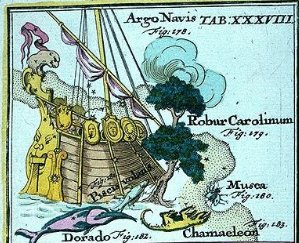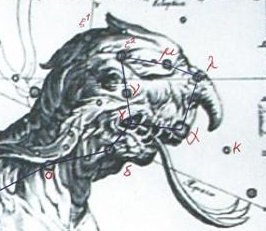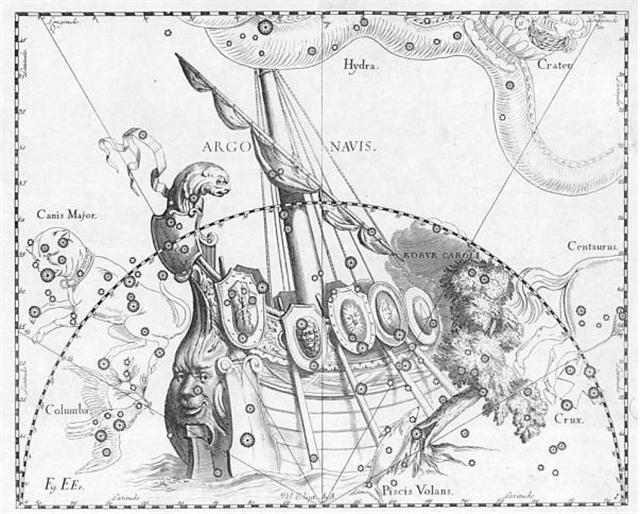424. By using the time-frame of Bharani
as a stepping stone
it was evidently possible to go back in time-space to the age
of Virgo by reducing its right ascension day numbers
with 80. This will bring us to the time when Argo Navis was
at 0h and Spica in day *80.

 |
 |
 |
 |
 |
 |
|
*Ca14-18 |
*Ca14-19 |
*Ca14-20 (383) |
(6 + 378) |
*Ca14-22 |
*Ca14-23 |
|
CLOSE TO THE SUN: |
|
(461 - 182 = 279) |
7 |
8 (281) |
Oct 9 |
10 |
11 (284) |
|
AL DAFĪRAH (Tuft) = β Com. Ber.
(199.4) |
σ Virginis (200.4)
*159.0 = *200.4 - *41.4 |
γ Hydrae (201.0), ι Centauri (201.4) |
Al Simāk-12 (Lofty) /
Chitra-14 (Bright One) /
Horn-1 (Crocodile) /
Sa-Sha-Shirū-20
(Virgin's Girdle) /
ANA-ROTO-3 (Middle pillar)
MIZAR =
ζ
Ursae Majoris (202.4), SPICA =
α
Virginis, ALCOR = 80 Ursae Majoris
(202.7)
SADALMELIK (α Aquarii)
*161.0 = *202.4 - 41.4 |
71 VIRGINIS
(203.6) |
no star listed (204) |
 |
|
CLOSE TO THE FULL MOON: |
|
(86 + 375 = 461) |
(462 - 366 = 96) |
April 7 (*383) |
8 (464) |
9 |
10 (100) |
|
1h (15.2)
β Phoenicis (15.1), υ Phoenicis, ι
Tucanae (15.6), η Ceti, ζ Phoenicis
(15.7) |
Al Batn Al Hūt-26 (Belly of the
Fish) /
Revati-28 (Prosperous) /
1-iku (Field Measure)
MIRACH (Girdle) = β Andromedae, KEUN
MAN MUN (Camp's South Gate) = φ
Andromedae
(16.0),
ANUNITUM = τ Piscium
(16.5),
REVATI (Abundant) = ζ Piscium
(16.9)
REGULUS
(α Leonis) |
ν Phoenicis (17.4), κ Tucanae (17.6)
*342.0 = *383.4 - *41.4 |
no star listed (18) |
ADHIL (Garment's Train) = ξ
Andromedae
(19.3), θ Ceti (19.7) |
KSORA (Knee) = δ Cassiopeiae
(20.1), ω Andromedae (20.6), γ
Phoenicis (20.8) |
|
... Though Andromeda has its roots
most firmly in the Greek tradition,
a female figure in Andromeda's place
appeared in Babylonian astronomy.
The stars that make up Pisces and
the middle portion of modern
Andromeda formed a constellation
representing a fertility goddess,
sometimes named as Anunitum
or the Lady of the Heavens ...
 |
 |
 |
 |
 |
 |
 |
|
*Ca14-24 |
*Ca14-25 |
*Ca14-26 |
*Ca14-27 |
*Ca14-28 |
*Ca14-29 (392) |
|
CLOSE TO THE SUN: |
|
Oct 12 |
13 |
14 |
15 (288 =
☼204) |
16 |
17 (392 + 80 - 182) |
|
HEZE =
ζ
Virginis
(205.0),
Southern Pinwheel Galaxy = M83
Hydrae
(205.7) |
ε Centauri (206.3), κ Oct. (206.4) |
no star listed (207) |
τ
Bootis (208.2),
BENETNASH (Leader of the Daughters
of the Bier) =
η
Ursae Majoris
(208.5),
ν
Centauri (208.7),
μ
Centauri,
υ
Bootis (208.8) |
no star listed (209) |
MUPHRID (Solitary Star) = η Bootis
(210.1), ζ Centauri (210.3) |
 |
|
CLOSE TO THE FULL MOON: |
|
April 11 |
12 |
13 |
14 (104 =
☼20) |
15 |
16 (392 - 366 + 80) |
|
δ Phoenicis (21.5) |
υ Andromedae (22.9) |
ACHERNAR (End of the River) = α
Eridani
(23.3), χ Andromedae (23.6), τ
Andromedae (23.9) |
ALSEIPH (Scimitar) = φ Persei
(24.5), τ Ceti (24.7) |
no star listed (25) |
ANA-NIA-10 (Pillar-to-fish by)
χ
Ceti (26.1),
POLARIS = α Ursae Minoris, BATEN
KAITOS (Belly of the Fish) = ζ
Ceti
(26.6),
METALLAH = α Trianguli
(26.9) |
 |
Compared to what I have
suggested earlier I have above now changed the
position of the Solitary Star (Muphrid) to
be at the end of side a instead of at the
beginning of side b. 210 = half 420 = 7 *
30 = half the number of assessors in the Hall
of the Two Truths:
...
The four bereaved and searching divinities,
the two mothers and their two sons, were
joined by a fifth, the moon-god Thoth (who
appears sometimes in the form of an
ibis-headed scribe, at other times in the
form of a baboon), and together they found
all of Osiris save his genital member, which
had been swallowed by a fish. They tightly
swathed the broken body in linen bandages,
and when they performed over it the rites
that thereafter were to be continued in
Egypt in the ceremonial burial of kings,
Isis fanned the corpse with her wings and
Osiris revived, to become the ruler of the
dead. He now sits majestically in the
underworld, in the Hall of the Two Truths,
assisted by forty-two assessors, one from
each of the principal districts of Egypt;
and there he judges the souls of the dead.
These confess before him, and when their
hearts have been weighed in a balance
against a feather, receive, according to
their lives, the reward of virtue and the
punishment of sin ...
 |
 |
 |
 |
|
Cb1-1 (393) |
Cb1-2 |
Cb1-3 |
Cb1-4
(396) |
|
E tupu |
ki roto |
o te hau tea |
ki te henua - te
maro |
|
Oct 18
(291) |
19 (212 + 80) |
20 |
21 |
|
φ Centauri (211.0), υ¹ Centauri
(211.1), υ² Centauri (211.8), τ
Virginis (211.9) |
AGENA (At the Knee) =
β
Centauri
(212.1),
θ
Apodis (212.5),
THUBAN (Dragon) =
α
Draconis
(212.8) |
14h (213.1)
π
Hydrae,
χ
Centauri (213.0),
MENKENT (Shoulder of the Centaur) =
θ
Centauri
(213.1) |
Neck-2 (Dragon)
ASELLUS TERTIUS (3rd Ass Colt) = κ
Bootis,
κ Virginis,
14 Bootis
(214.8) |
|
1 |
Horn |
α Virginis (Spica) |
Crocodile |
(202.7) |
Oct 9 (282) |
|
2 |
Neck |
κ Virginis |
Dragon |
(214.8) |
Oct 21 (294) |
|
|
April 17 (107) |
18 (28 + 80) |
19 |
20 |
|
'March 21 (0h) |
22 (81 = 108 - 27) |
23 |
24 |
|
Al Sharatain-1 /
Ashvini-1 /
Bond-16 (Dog) /
Mahrū-sha-rishu-ku-1 (Front of the
Head of Ku)
SEGIN = ε Cassiopeia, MESARTHIM = γ
Arietis,
ψ Phoenicis (27.2),
SHERATAN (Pair of Signs) = β Arietis,
φ Phoenicis (27.4)
*352.0 = *27.4 - *41.4 |
ι
Arietis (28.0), λ Arietis (28.2) |
ALRISHA (The Knot) = α Piscium,
χ Phoenicis (29.2),
ALAMAK (Caracal) = γ Andromedae
(29.7) |
Arku-sha-rishu-ku-2 (Back of the
Head of Ku)
2h (30.4)
κ Arietis (30.3),
HAMAL (Sheep) = α Arietis
(30.5)
ALKES (α
Crateris) |
 |
Turning the tablet around
from side a to side b could perhaps have
been
compared to changing from daytime to
nighttime, or from north to south, or from
east to west, or from flowing down to
floating up, etc.

and the First Point of Aries
(Sheratan) had been at 0h when Julius Caesar
launched his new Sun calendar. At the time
of rongorongo
Sheratan could in principle be observed
close to the Full Moon in October 18,
although the Sun light of the southern spring gradually
caused the star observations to become more
difficult. 393 = 366 + 27.
 |
 |
 |
 |
 |
 |
|
Cb1-5 |
Cb1-6 (398) |
Cb1-7 |
Cb1-8 |
Cb1-9 |
Cb1-10 |
|
CLOSE TO THE SUN: |
|
Al Ghafr-13 (The Cover) /
Svāti-15 (Very Good) /
TAHUA-TAATA-METUA-TE-TUPU-MAVAE-6
(a pillar to stand by)
15 Bootis (215.2),
ARCTURUS = α Bootis
(215.4),
ASELLUS SECUNDUS (2nd Ass Colt)
= ι Bootis
(215.5),
SYRMA (Train of the Virgin's
Robe) = ι Virginis,
λ Bootis (215.6), η Apodis
(215.8)
*174.0 = *215.4 - *41.4 |
ι Lupi, 18 Bootis (216.3),
KHAMBALIA (Crooked-Clawed) = λ
Virginis
(216.4), υ Virginis (216.5), ψ
Centauri (216.6), ε Apodis
(216.8)
*175.0 = *216.4 - *41.4 |
ASELLUS PRIMUS (1st Ass Colt) =
θ Bootis
(217.8) |
τ Lupi, δ Oct. (218.1), φ
Virginis (218.7)
FOMALHAUT (α Piscis Austrini) |
σ Lupi (219.1), ρ Bootis
(219.5), HARIS
(Keeper) = γ Bootis
(219.7) |
σ Bootis (220.2), η Centauri
(220.4)
*179.0 = *220.4 - *41.4 |
|
CLOSE TO THE FULL MOON: |
|
η Arietis (31.9) |
ξ¹ Ceti (32.1) |
χ Persei (33.2), θ Arietis
(33.3),
MIRA (Next to the Pleiades) = ο
Ceti
(33.7) |
no star listed (34) |
ξ Arietis (35.0), ρ Ceti (35.4),
ξ² Ceti (35.9)
*360.0 = *35.4 - *41.4 |
σ Ceti (36.9) |
|
... Although an old
constellation, Cetus is by no
means of special interest,
except as possessing the south
pole of the Milky Way and the
Wonderful Star, the variable
Mira; and from the fact that it
is a condensation point of
nebulae directly across the
sphere from Virgo, also noted in
this respect ...
... Mira also known as
Omicron Ceti (ο Ceti,
ο
Cet), is a red giant star
estimated 200-400 light years
away in the constellation Cetus.
Mira is a binary star,
consisting of the red giant Mira
A along with Mira B. Mira A is
also an oscillating variable
star and was the first
non-supernova variable star
discovered, with the possible
exception of Algol. Apart from
the unusual Eta Carinae, Mira is
the brightest periodic variable
in the sky that is not visible
to the naked eye for part of its
cycle ...
In a way Mira therefore
can illustrate how life (light)
departs, yet returns again after
the completion of a cycle.
... In 1638 Johannes Holwarda
determined a period of the
star's reappearances, eleven
months; he is often credited
with the discovery of Mira's
variability. Johannes Hevelius
was observing it at the same
time and named it 'Mira'
(meaning 'wonderful' or
'astonishing,' in Latin) in
1662's Historiola Mirae
Stellae, for it acted like
no other known star. Ismail
Bouillaud then estimated its
period at 333 days, less than
one day off the modern value of
332 days, and perfectly
forgivable, as Mira is known to
vary slightly in period, and may
even be slowly changing over
time ...
 |
|
84 |
 |
 |
 |
|
Cb5-1 (392 + 95) |
Cb5-2 (488) |
Cb5-3 |
|
Te ragi |
tagata - ragi |
kua hakagana - ki te
maro |
|
CLOSE TO THE SUN: |
|
SHANG WEI (Higher Guard) = κ Cephei
(305.2), θ Sagittae (305.4),
TSEEN FOO (Heavenly Raft) = θ
Aquilae (Ant.)
(305.6), ξ Capricorni (305.8)
*264.0 = *305.4 - *41.4 |
TSO KE (Left Flag) = ρ Aquilae
(306.3) |
GREDI (Goat) = α Capricorni
(307.2), σ Capricorni (307.5),
ALSHAT (The Sheep) = ν Capricorni
(307.9) |
 |
|
Jan 20 (385) |
21 |
22 |
|
"Dec 10 (*264.0 = *305.4 - *41.4) |
11 (345) |
12 |
|
CLOSE TO THE FULL MOON: |
|
8h (121.7)
χ Gemini (121.0),
NAOS = ζ Puppis
(121.3) |
ρ
Puppis (122.0),
HEAP OF FUEL =
μ
Cancri
(122.1),
ζ
Monocerotis (122.3), ψ
Cancri (122.6),
REGOR (Roger backwards) =
γ
Velorum
(122.7) |
TEGMINE = ζ Cancri
(123.3) |
|
July 20 (*121) |
21 |
22 (22 / 7 →
π) |
|
"June 9 (*121 - *41 = *80) |
He Maro 10 (161) |
11 |
|
... The month, which takes its name from Juppiter
the oak-god, begins on June 10th and ends of July
7th. Midway comes St. John's Day, June 24th, the day
on which the oak-king was sacrificially burned
alive. The Celtic year was divided into two halves
with the second half beginning in July, apparently
after a seven-day wake, or funeral feast, in the
oak-king's honour ...
|
he nape mai a Makoi.i te
ingoa. ko hanga te pau ko te
tomonga o Ira. |
Makoi
named the place Hanga Te
Pau, 'the landing site
of Ira'. |
|
he aringa.ko mua a hanga te
pau. |
So that they would remember
(? he aringa,
literally, 'as face'), the
open side of Hanga Te Pau |
|
i nape ai te ingoa. |
was given this name. |
|
he ea.a Ira.he iri he oho ki
runga anake. |
Ira
got up. They all climbed to
the top of the hill. |
|
i te angahuru o te ra o te
maro i iri ai. |
They climbed up on the tenth
day of the month of June 'Maro'. |

*41.4 + *80 = *121.4 and 121.4 /
365.25 * 26000 was 8642 years before the time of
rongorongo. 8642 - 1842 AD = 6800 BC, when the
northern vernal equinox had been in Cancer.
12500 BC (cfr the illustration above) - 6800 BC =
5700 years corresponds to 5700 / 26000 *
365.25 = 80 right ascension days, which means that
in the age of Cancer (6800 BC) the thong which held
it all together would have been around June 9 (80 +
80). |

|

























